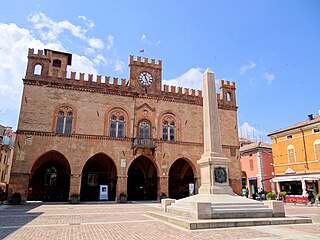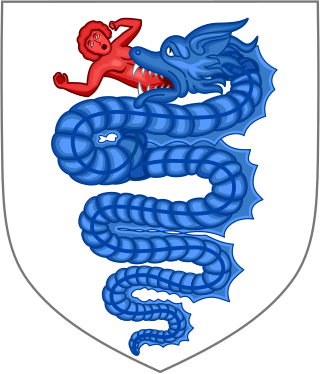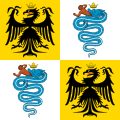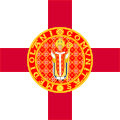
Francesco I Sforza was an Italian condottiero who founded the Sforza dynasty in the duchy of Milan, ruling as its (fourth) duke from 1450 until his death.

Como is a city and comune in Lombardy, Italy. It is the administrative capital of the Province of Como.

In heraldry, Saint George's Cross is a red cross on a white background, which from the Late Middle Ages became associated with Saint George, the military saint, often depicted as a crusader.

A saltire, also called Saint Andrew's Cross or the crux decussata, is a heraldic symbol in the form of a diagonal cross. The word comes from the Middle French sautoir, Medieval Latin saltatoria ("stirrup").

The Visconti of Milan are a noble Italian family. They rose to power in Milan during the Middle Ages where they ruled from 1277 to 1447, initially as Lords then as Dukes, and several collateral branches still exist. The effective founder of the Visconti Lordship of Milan was the Archbishop Ottone, who wrested control of the city from the rival Della Torre family in 1277.

The Duchy of Milan was a state in Northern Italy, created in 1395 by Gian Galeazzo Visconti, then the lord of Milan, and a member of the important Visconti family, which had been ruling the city since 1277.

Filippo Maria Visconti was duke of Milan from 1412 to 1447. Known to be cruel and paranoid, but shrewd as a ruler, he went to war in the 1420s with Romagna, Florence and Venice in the Wars in Lombardy, but was eventually forced to accept peace under Pope Martin V. He would return to the offensive again where another peace agreement was required to end the fighting. He married twice, the second in 1428 to Marie, daughter of his ally Amadeus VIII. When he died, he was the last of the Visconti male line and was succeeded by Francesco Sforza, husband to his daughter.

Fidenza is a town and comune (municipality) in the province of Parma, in the Emilia-Romagna region of Italy. It has around 27,000 inhabitants. The town was renamed Fidenza in 1927, recalling its Roman name of Fidentia; before, it was called Borgo San Donnino.

The Archdiocese of Milan is a Latin Church ecclesiastical territory or archdiocese of the Catholic Church in Italy which covers the areas of Milan, Monza, Lecco and Varese. It has long maintained its own Latin liturgical rite usage, the Ambrosian rite, which is still used in the greater part of the diocesan territory. Among its past archbishops, the better known are Ambrose, Charles Borromeo, Pope Pius XI and Pope Paul VI.

The Golden Ambrosian Republic was a short-lived republic founded in Milan by members of the University of Pavia with popular support, during the first phase of the Milanese War of Succession. With the aid of Francesco Sforza they held out against the forces of the Republic of Venice, but after a betrayal Sforza defected and captured Milan to become Duke himself, abolishing the Republic.

Parabiago is a town located in the north-western part of the Metropolitan City of Milan, Lombardy, northern Italy.
Cesana Brianza is a municipality of 2,393 inhabitants in the Province of Lecco in Lombardy, about 40 kilometres (25 mi) north of Milan and 9 kilometres (5.6 mi) southwest of Lecco.

The biscione, less commonly known also as the vipera, is in heraldry a charge consisting of a divine serpent in the act of giving birth to a child. It is a historic symbol of the city of Milan, used by companies based in the city.

Milan, Italy is an ancient city in northern Italy first settled under the name Medhelanon in about 590 BC by a Celtic tribe belonging to the Insubres group and belonging to the Golasecca culture. The settlement was conquered by the Romans in 222 BC and renamed it Mediolanum. Diocletian divided the Roman Empire, choosing the eastern half for himself, making Milan the seat of the western half of the empire, from which Maximian ruled, in the late 3rd and early 4th century AD. In 313 AD Emperors Constantine and Licinius issued the Edict of Milan, which officially ended the persecution of Christians. In 774 AD, Milan surrendered to Charlemagne and the Franks.

Lombard nationalism is a nationalist, but primarily regionalist, movement active primarily in Lombardy, Italy. It seeks more autonomy or even independence from Italy for Lombardy and, possibly, all the lands that are linguistically or historically Lombard. During the 1990s, it was strictly connected with Padanian nationalism.
The Milanese War of Succession was a war of succession over the Duchy of Milan from the death of duke Filippo Maria Visconti on 13 August 1447 to the Treaty of Lodi on 9 April 1454.

The flag of Lombardy is one of the official symbols of the region of Lombardy, Italy. The current flag was officially adopted on 4 February 2019, although it has been used de facto since 12 June 1975.

The three symbols of Milan, the capital city of Lombardy, are the coat of arms, the gonfalon and the flag, as stated in the municipal charter.























